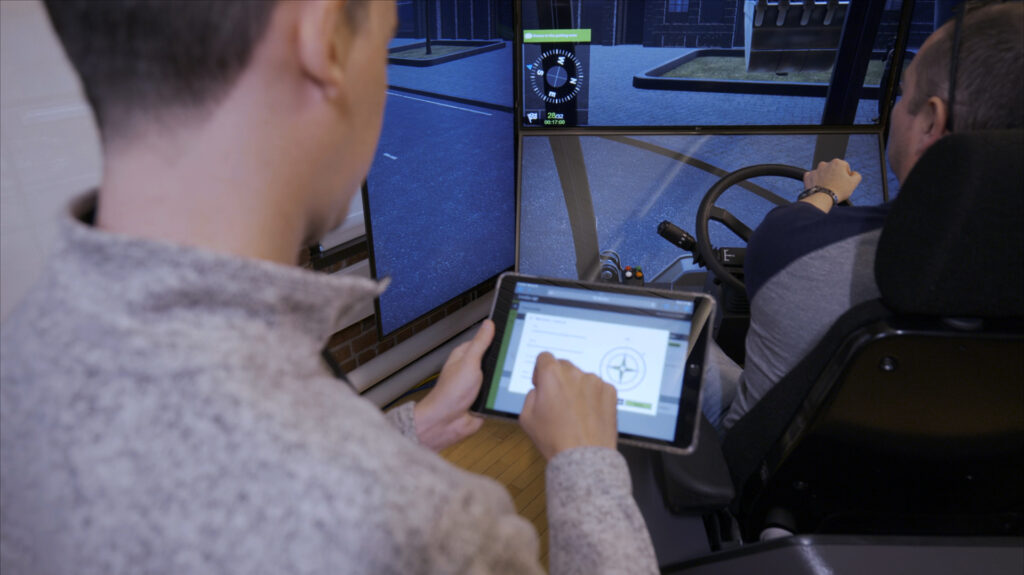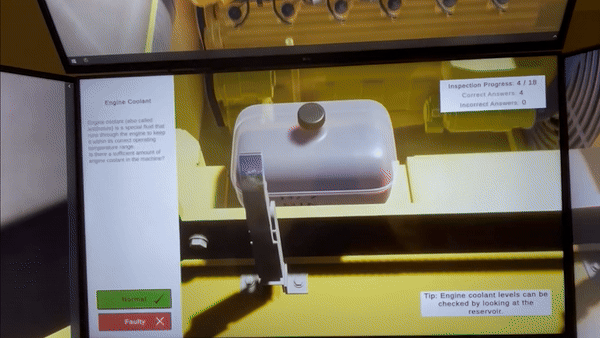Headquartered in Countryside, Illinois, IUOE Local 150 represents approximately 23,000 members, and trains apprentices in numerous industries, including earth moving, hoisting, concrete pumping, drilling, landscape construction, pipeline construction, aggregate production and others.
In order to accommodate an influx of trainees, Local 150 turned to a high-tech solution: Vortex simulators from CM Labs.
“Deploying Vortex simulators is our answer to being able to train twice as many people in the same amount of time,” said Mark Kara, Assistant Coordinator of the Local 150 Apprenticeship Program.
It was while testing a Vortex simulator from CM Labs that Kara experienced the effectiveness of this training solution first-hand.
“Just 20 minutes after training had started, one of our apprentices was leaving. When I asked why, he said it was because there was no equipment in the yard for him to run,” said Kara.
The apprentice, who had little to no experience operating cranes, had been wanting to work on his rough terrain crane proficiency skills. Kara proposed he try the Vortex crane simulator instead, with a crane instructor to guide him.
At the end of the week two apprentices took a timed crane proficiency test — one that had been trained on the simulator, and the other that had only trained on the real equipment.
“The apprentice using the simulator to train passed the proficiency test his first time around. The other individual did not. That’s a big testament to this crane simulator. For an entry-level crane operator to transfer out of the seat of a simulator into the seat of a real crane, and pass the exam—that’s significant,” said Kara.
Multiple Returns on Investment
To meet the heightened training demand generated by a $45-billion dollar state infrastructure bill, Local 150 purchased 11 new Vortex simulators installed with dozer, loader, excavator, and backhoe training packs. This was in addition to the dedicated crane simulators (tower crane, luffing tower crane, and rough terrain crane), it had acquired the previous year from CM Labs.
There were several factors that influenced the decision. Local 150 was impressed by the flexibility to deploy different training packages on a Vortex simulator so that it could be used for multiple types of equipment. One simulator can be used to run any training pack from CM Labs’ catalogue of crane and earthmoving equipment, and switch from ISO- to SAE-style controls as needed.
Kara explained that this gives even journeyman operators the chance to freshen their skills if they are used to operating one type, but need to operate the other type for an upcoming job.
The simulators also are an invaluable resource when the crane field is shut down due to rain or lightning.
Local 150 also finds that deploying Vortex simulators results in a more efficient use of training resources. Assigning one instructor for 10 students on simulators for the first several days of class frees up an instructor to go in the field with a different group of students who have advanced to the hands-on, live equipment portion. This keeps the instructor-to-student ratio low in the field, where it matters most, explained Kara.
“There are skill sets that can be taught better on a simulator because of the immediate feedback the simulator provides. There are so many things to focus on, that the instructor can’t watch everybody, every minute. But the simulator is watching the student the entire time.
“We can go back and look at the data — how much fuel was consumed, how many times the operator hit the truck with the bucket, how full the bucket was, the cycle times, and so on. Then we can sit down and talk about how to fix it.”
Kara observes that simulators give new operators more confidence because they can concentrate on mastering a new skill without the fear of getting hurt or damaging equipment. Likewise, the economics of saving fuel and wear and tear on real equipment helps Local 150 to better manage their resources.
Smart Training Technology Provides Critical Training Advantage
Another factor in Local 150’s decision was the realism of the training solutions.
“It’s not just the motion that seems real,” Kara said. “The simulator actually creates a feeling of pulling, having resistance as you dig with the bucket, giving feedback of just scratching the ground versus sticking the bucket completely in the ground. It acts like an actual excavator would feel.”
This real feel of CM Labs’ simulation-based training solutions is due to Smart Training Technology. Comprised of CM Labs’ proprietary and patented algorithms, Smart Training Technology is what ensures that Vortex simulators deliver the most transferable operator skills anywhere, outside the real equipment, the company said.
Kara finds that simulators can be instrumental in terms of how insurance companies perceive an organization’s training approach.
“On the training side of things, simulators help operators understand when something’s not right, and when they should be saying ‘no’.
“That’s what insurance companies are interested in, is, if your operator sees an unsafe act about to happen, will they do something to stop it? On a simulator, we can show trainees unsafe situations. We can go beyond and show them why it’s unsafe. You can’t do that on the real equipment.”


